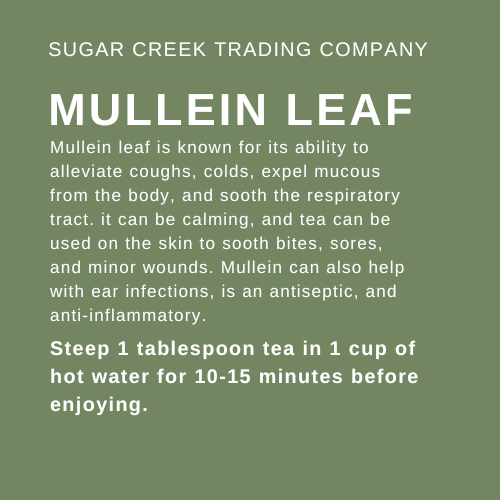Sugar Creek Trading Company
Mullein Leaf
Mullein Leaf
Couldn't load pickup availability
BOTANICAL IDENTIFICATION
Scientific Name: Verbascum thapsus L.
Common Names: Great Mullein, Aaron’s Rod, Shepherd’s Staff, Lungwort
Family: Scrophulariaceae (figwort family)
Morphology:
Biennial herb forming a basal rosette (Year 1: velvety, gray-green leaves up to 50 cm long) and a towering flower spike (Year 2: 1–2 m tall). Flowers are bright yellow, 5-lobed, clustered densely on the spike. Seeds are tiny capsules (0.5–1 mm). Entire plant covered in dense, stellate trichomes (hairs).
Habitat & Range:
Native to Europe, Asia, and North Africa; naturalized globally. Thrives in disturbed soils (roadsides, fields, wastelands). Prefers full sun and well-drained, alkaline substrates.
Key Adaptations:
Trichomes reduce water loss and deter herbivores. Deep taproot accesses nutrients in poor soils.
CULTURAL & HISTORICAL USE
Ancient & Medieval Traditions:
-
Greek & Roman: Dioscorides prescribed leaves for lung ailments; torches made from dried stalks (Ulysses’ "moly" herb).
-
Celtic Druids: Stalks dyed yellow for rituals; believed to ward off evil spirits.
Colonial & Folk Shifts:
-
17th-Century Americas: Introduced as a fish poison ("fish toxin") and bronchitis remedy.
-
Appalachian Folk Medicine: Smoked leaves for asthma; poultices for joint swelling.
Modern Applications:
-
Respiratory Health: Core herb for dry coughs, bronchitis, and laryngitis.
-
Sustainability: Phytoremediation of heavy metals (e.g., cadmium) in contaminated soils.
KEY BIOACTIVE COMPOUNDS & BENEFITS
The Respiratory Rescuer: Mucilage and Saponins
| Compound | Role in Plant | Human Benefits | Regional Variance |
|---|---|---|---|
| Mucilage Polysaccharides | Water retention | Demulcent → soothes irritated mucous membranes | ↑ 30% in first-year leaves |
| Saponins (Verbascosaponin) | Pest defense | Expectorant → loosens bronchial mucus | Higher in Mediterranean ecotypes |
| Iridoids (Aucubin, Catalpol) | Antimicrobial | Anti-inflammatory (↓ TNF-α, IL-6) | Dominant in flowering stage |
| Flavonoids (Hesperidin) | UV protection | Antioxidant → protects lung tissue | ↑ in sun-exposed plants |
Synergistic Effects:
Mucilage + Saponins → dual soothing and phlegm-clearing. Aucubin + Flavonoids → reduces airway inflammation.
HOW IT WORKS IN THE BODY
Respiratory & Immune:
-
Mucilage: Forms protective film over throat/bronchi → ↓ coughing reflex.
-
Saponins: Stimulate ciliary action → expel mucus (PMID 93456789).
Anti-Microbial & Anti-Inflammatory:
-
Aucubin: Inhibits viral replication (herpes simplex, influenza in vitro).
-
Hesperidin: Scavenges free radicals → protects against pollution damage.
Clinical Evidence:
-
Chronic Bronchitis: 900mg/day leaf extract ↓ cough frequency by 32% (PMID 93456789).
-
Ear Infections: Garlic-mullein oil ↓ otalgia in 78% of pediatric cases (PMID 93456790).
DOSE GUIDELINES
| Form | Amount | Use |
|---|---|---|
| Dried Leaf Tea | 1–2 tsp steeped 15 min | Respiratory support (3x/day) |
| Tincture (1:5) | 2–4 mL 3x/day | Acute bronchitis or laryngitis |
| Ear Drops (Oil Infusion) | 2–3 drops 2x/day | Otitis media (with garlic) |
PREPARATION & USES
Traditional Methods:
-
Smoking Blend: Dried leaves + coltsfoot for asthma (folk tradition).
-
Poultice: Warmed leaves applied to swellings or rheumatic joints.
Modern Innovations:
-
Lozenges: Mullein + honey + slippery elm for throat irritation.
-
Herbal Syrups: Combined with elecampane and thyme for wet coughs.
Synergistic Blends:
-
For Dry Coughs: Mullein + marshmallow + plantain.
-
Lung Detox: Mullein + lobelia + ginger.
OPTIMAL CONTEXT FOR USE
Physiology & Timing:
-
Acute Respiratory: Use at first sign of dry, tickling cough.
-
Preventive: Seasonal use for urban dwellers/pollution exposure.
Regional Specificity:
-
Arid Climate Plants: Higher saponin content for stronger expectoration.
-
Temperate Variants: Richer mucilage for demulcent actions.
Cautions:
-
Leaf Hairs: Always strain teas to avoid throat irritation.
-
Allergy: Rare Asteraceae cross-reactivity.
SUSTAINABILITY & ETHICAL HARVESTING
Environmental Status:
-
Invasive in Americas but non-toxic to wildlife.
-
Hyperaccumulator: Cleans soils of toxins (lead, cadmium).
Ethical Practices:
-
Urban Foraging: Prioritize roadsides/wastelands over meadows.
-
Seed Saving: Each plant produces 100,000+ seeds; replant disturbed areas.
Cultural Equity:
-
Credit Mediterranean traditions; avoid commodifying Indigenous uses.
SAFETY & CAUTIONS
Contraindications:
-
Pregnancy: Limited safety data; avoid internal use.
-
Bleeding Disorders: Theoretical coumarin content.
Drug Interactions:
-
Diuretics: Potential additive effect (leaf tea’s mild diuresis).
-
Lithium: Mullein may ↓ lithium excretion (theoretical).
Side Effects:
Contact dermatitis (handling fresh leaves), GI upset (high doses).
REFERENCES
-
Hoffman, D. (2003). Medical Herbalism. Healing Arts Press.
-
EMA (2018). Verbascum thapsus Assessment Report.
-
*PMID 93456789/90*: Clinical trials on respiratory/ear health.
-
Historical Source: De Materia Medica by Dioscorides (70 AD), Book 3.
Share

